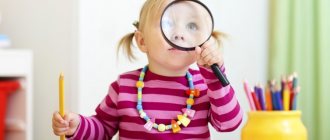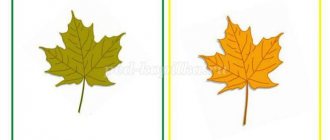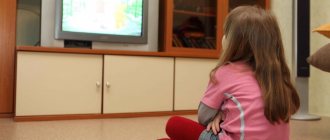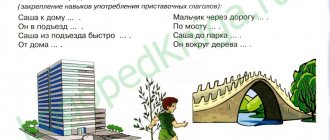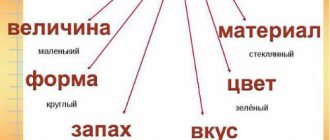Many parents believe that to prepare their child for school life, the basics of reading, writing and mathematics will be enough. In reality, things are somewhat more complicated. It would be optimal to choose an individual program for the development of your child, including various aspects, which include memory, speech, perception, thinking, imagination. In our article we will talk about what developmental activities for preschoolers should be aimed at and present some of them.
Classes with a preschooler should be regular
Preparation for classes
Before working with your child, you need to prepare a workplace. It can be in any room.
An important circumstance is one condition: everything necessary should be at hand, and nothing should distract the child from the educational process.
Approximate class schedule
It would be nice to bring the form of the lesson as close as possible to the school process. It is necessary to determine the duration of the process, but it should be remembered that a child of 5-6 years old cannot exercise for more than 20 minutes. If in the future he adapts well to the process, then, provided that it is not difficult and interesting for the baby, you can increase it to 30 minutes.
You need to tell the child about the school bell, its functions, what recess is, how to behave during it, why the student is called to the blackboard, about the diary, the teacher. All this is important for his future adaptation to school life.
Tasks for the development of auditory memory
In school life, a child’s auditory memory is often involved; in order to make it easier for the child to cope with tasks, it would be a good idea to conduct developmental activities with him. To develop auditory memory, you can do the following exercise. You should name the child 10 unrelated words, for example, cat, chair, forest, hand, brother, berry, car, house, elephant, door. At home, it happens that parents name words according to the principle that what I see is what I say. However, the baby can also see these objects, and he does not need to remember the words.
Developing auditory memory through reading aloud
Therefore, it is better to write down the words on a piece of paper and work with a pre-prepared list. The items on the list should be familiar to the baby. Normally, he should name at least 5 words, in any order.
The words can be repeated several times, then you need to give the baby the opportunity to repeat the words on his own. It happens that after the third repetition he names all the words, and after the fourth he names only one. You should not get angry with him, as this may be an indicator that the child is not psychologically ready for the lesson. He gets tired quickly. This situation can be correlated with the school process, for example, when learning a poem, it should be understood that frequent repetition will only worsen the situation.
Lesson on memorizing words and names
Psychologists recommend building a graph that will immediately show how your child’s auditory memory works. A zigzag graph indicates instability of attention as a sign of hyperactivity.
Olga Naumova “Learning to compare”
Preschool children often have difficulty making comparisons. The ability to compare is one of the most important mental operations, which is based on developed speech, logic and observation. Therefore, it is extremely important from early childhood to stimulate the development of logical thinking, attention, and observation in children. Along with these skills, the child’s speech develops and his vocabulary is enriched.
Download the book by O. Naumov “Learning to Compare”
Visual memory development task
To develop visual memory, you need to prepare 10 pictures for the child, and they should be familiar to him. The objects depicted on them must be recognizable and clear. In addition, there should not be anything superfluous on them, for example, if a bench is depicted with a hare sitting on it, then the child can remember both the bench and the hare. During the lesson, the pictures should be laid out one by one, while naming them out loud, since he may mistake the pictured chair for a sofa. After all the images have been laid out, he needs to be given a minute to memorize.
Visual memory activity - showing pictures and talking about them
If the child is confused or has named few words, then you can work with him in the same way with fewer images. For better memorization, it is recommended to connect words with each other in meaning and come up with a story with them.
Assignment on the lexical topic: “Pisces”
Exercise “Little fish and giant fish.” Formation of word formation skills, the use of nouns with the suffixes -ish, -ishka:
gudgeon - gudgeon - gudgeon ruff - brush - ruff,
shark - sharks fish - fish - fish
crucian carp - crucian carp - crucian carp perch - perch - perch
Guess the riddles. Explain how you guessed what words helped you find the answers.
She lives in water.
There is no beak, but it pecks. (Fish)
It crawls the other way around - backwards. (Cancer)
She is the storm of the seas
Get away from her quickly! (Shark)
Development of sound and letter analysis skills.
Draw or stick 10 fish. Write short words in their entirety, and write the first and last letter of long ones.
For example: catfish - COM, flounder - K________A
Learn a poem with your child. Do finger exercises with him.
Fish
The fish swims in the water, the fish arches its back,
The fish have fun playing. I took a bread crumb.
Fish, fish, mischief, The fish waved its tail,
We want to catch you. The fish quickly swam away.
Top
Development of semantic memory
To develop semantic memory, you can name paired words, for example, house-window, bear-raspberry, table-chair, forest-tree, winter-snow. Then you should name the words from the first pair, and name the baby from the second. You can start with three semantic pairs, then as the baby understands what they want from him, you can increase the number of pairs. If he cannot understand what is required of him, he needs to explain in more detail, for example, a forest is a tree, a tree grows in a forest. Normally, out of five pairs, the baby should name three.
Development of semantic memory for older preschoolers using pictures
Moreover, different thematic words should be chosen for boys and girls. Typically, 6-year-old children successfully complete this task on the third attempt.
Task for the development of logical thinking
Tasks for preschoolers are not possible without the development of logic. Working with the logic of preschoolers is aimed at finding an extra object. In the beginning, it is advisable to use not pictures, but toys and other objects, for example, among the vegetables there is one berry or among the yellow objects there is one blue one. Later it’s worth moving on to the pictures.
Cognitive development in logical problems
Also, at first you can make a more expressive difference, for example, put a car among the images of birds, then it’s worth making it a little more complicated: put one domestic animal among wild animals.
For beginner children, there is no need to carry out multivalued rows, when several objects will be superfluous, but each according to its own characteristics, for example, among circles, one will be large, and one of a different color. This way they can only be confused. Such activities can be done by already prepared children who have good sense of direction and justify the answer, for example, the odd one in shape, color, size.
Logical exercises for children 5-6 years old - preparation for school
Stories based on pictures are good for developing logical thinking. After offering the child several pictures, you need to ask him to make up a story and put the pictures in order. That is, first the baby woke up, then went to brush his teeth, and then went for a walk. If he has a contradictory story, then you shouldn’t criticize him. It would be more correct to offer him your own version of the story, while not forgetting to praise the baby.
Logic blocks Dendeshi - excellent educational material
Before going to school, children should be well versed in geometric shapes and space.
Lesson with geometric shapes - development of spatial thinking and hand motor skills
Developmental tasks ask them to draw a circle under a square, an oval in a square, a triangle in a circle. Draw a ball in the upper right corner, a carrot in the upper left, an apple in the lower left, a Christmas tree in the lower right, and a bear in the center.
Consultation for parents “Doing tasks with children at home”
Tatiana Chugunkina
Consultation for parents “Doing tasks with children at home”
Consultation for parents
“Doing tasks with children at home”
All parents dream of a child being healthy, obedient, smart and beautiful. However, children, as a rule, have their own plans in this regard. They do not yet understand that intelligence and knowledge in the modern world are power. And it’s impossible to explain this to them.
So what remains for parents? There may be two options here. Either resign yourself and let everything take its course, or look for tricks and use cunning in order to still instill in your baby such useful skills and abilities.
What is the importance of homework for children in kindergarten?
It is of great importance:
• Children begin to develop a sense of responsibility;
• Awareness that knowledge can be acquired by oneself (at this age, together with parents)
• children develop independent thinking skills;
Recommendations for parents to help them complete tasks with their children.
1. Do not turn the task into an instrument of torture.
It is important to interest the child in the task, tell him interesting facts, ones that will excite him and make him want to share his new knowledge with friends.
2.Form positive motivation for completing the task, its long-term perspective.
If your child refuses to complete tasks, you
• Gently but persistently get the job done.
• Complete tasks in a playful way, imagine a trip, find different motives for completing tasks each time
• Form cognitive interest in children:
1) Invite your child to play a board game, and he will not refuse.
2) You can use the technique with hobbies. Here it is important to understand what the child likes, and then adapt his interest to knowledge. For example, a child loves cars. Great, count them as you walk, combine them by color, etc.
3) Introduce your child to children's literature! Try to read at least a few pages, look at the pictures, ask them to describe them, ask your child questions about the text.
4) Arrange a joint modeling (from plasticine or from salt dough) And start sculpting, you can make a plot-based joint composition on the topic of the task.
5) Can you come up with a story for children in pictures? For example, take a stack of old magazines and cut out pictures from them: people, animals, plants. Then, together with the children, come up with the plot of a fairy tale and stick the pictures on a large sheet of paper. If some characters are missing, you can add them.
6) You can show your child a puppet show or invite him to show you the show himself, or better yet, arrange a joint performance for other family members.
7) Arrange a joint drawing on the topic of the task. Make a book from which the child can then tell others about the knowledge he has acquired.
3. Reward your child for a task well done. It is not acceptable to scold, get angry, or get irritated, otherwise a negative attitude towards completing tasks will be formed.
Educators offer homework not only in order to create and consolidate the child’s emotionally positive attitude towards learning, but also in order to strengthen contact between parents and child, which will help you in the future both at school and simply in life.
Remember that our goal is to teach the child not only to complete tasks,
but also to feel that his parents will always, in any situation, come to his aid, that
His difficulties will be successfully overcome with your help.
4. Don't try to complete the task for your child.
In preschool age, a child most often cannot complete a task on his own; help him cope, but together does not mean instead. Do not exclude the role of the child himself; he must take part in completing the task and, upon positive completion, feel a sense of satisfaction and pride in a well-done task. Praise your child for the slightest success, support him: “I know YOU CAN CANDLE IT,” “YOU WILL DEFINITELY SUCCEED IT.”
WE WISH YOU SUCCESS!
CHILDREN'S SUCCESS IS LIKE A BALM FOR THE HEART,
WHAT COULD BE BETTER FOR LOVING MOMS!
FROM THE FIRST SMILE TO VICTORY, FORWARD!
WE BELIEVE, FAMILY, LUCK IS WAITING FOR YOU!
Tasks for the development of phonemic hearing
An important step for Russian language classes will be developmental tasks aimed at phonemic hearing. First you need to teach your baby to clap words syllable by syllable. You need to start clapping words with 2 syllables, then 3, 4, and then 1 syllable. When dividing syllables, it is better to immediately introduce the baby to stressed and unstressed letters.
It is good for the development of phonemic hearing to connect a word with its corresponding diagram, the sounds in which are depicted in circles. Several words are written in a row, and opposite is a diagram with syllables. The child must find the necessary graphic image of the word. Moreover, the number of sounds in words should be different and the child should not be given words that have several sounds, such as fir-tree, yula, cabin boy. If the baby is not able to cope with the task, then you can first work out which sound is the first in the word and which is the last.
Phonemic lessons - you need to choose a methodology and use different types
The next step is to work on the vowels and consonants. Developmental tasks should be aimed at ensuring that vowels are sung, and consonants encounter an obstacle during pronunciation.
Tasks for the development of mathematical abilities
Developmental tasks for young preschoolers are not possible without mastering the basics of mathematics. Children should be given play activities to compare objects, for example, a Christmas tree is taller than a house, a rope is longer than a ribbon. In terms of quantity, you can offer your child a drawn train and ask him to paint the second carriage red, and the fifth one green. You can put wild animals in the red trailer, and a baby cow in the blue one, which is the third one. This way, the classes will be more interesting and will cover more than just mathematics.
You can start learning numbers from the age of 4
Logical problems like: “Sveta is taller than Seryozha, and Seryozha is taller than Lena” develop mathematical abilities well. Who's the tallest?
Developmental activities conducted with parents should take the form of a game, be interesting and fun. Then it will become a pleasant pastime not only for the kids, but also for their parents.
Olga Naumova “Logic”
The ability to think logically and reason is necessary for a child to successfully study at school - otherwise he may face difficulties in mastering basic subjects. This manual contains exercises that will help a future first-grader master basic skills - recognize objects by given characteristics, compare and find common and distinctive features, generalize, determine patterns and sequence of events, and solve simple logical problems.
